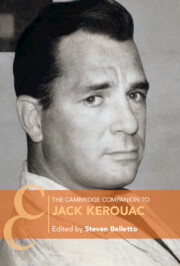Book contents
- The Cambridge Companion to Jack Kerouac
- The Cambridge Companion to Jack Kerouac
- Copyright page
- Contents
- Notes on Contributors
- A Kerouac Chronology
- Additional material
- Introduction
- Chapter 1 Kerouac’s Concept of His Duluoz Legend
- Chapter 2 Kerouac and the Profession of Authorship
- Chapter 3 Truth in Confession
- Chapter 4 The Textuality of Performance
- Chapter 5 The Spontaneous Aesthetic in The Subterraneans
- Chapter 6 Kerouac and the 1950s
- Chapter 7 The Impact of On the Road on the 1960s Counterculture
- Chapter 8 Vanity of Duluoz and the 1960s
- Chapter 9 Late Kerouac, or the Conflicted “King of the Beatniks”
- Chapter 10 Visions of Cody as Metafiction
- Chapter 11 Making the Past Present
- Chapter 12 Spun Rhythms
- Chapter 13 Kerouac’s Representations of Women
- Chapter 14 Kerouac and Blackness
- Chapter 15 Kerouac, Multilingualism, and Global Culture
- Chapter 16 The Two Phases of Jack Kerouac’s American Buddhism
- Chapter 17 Jack Kerouac’s Ambivalences as an Environmental Writer
- Chapter 18 The Essentials of Archival Prose
- Further Reading
- Index
- Cambridge Companions To …
Chapter 17 - Jack Kerouac’s Ambivalences as an Environmental Writer
Published online by Cambridge University Press: 31 October 2024
- The Cambridge Companion to Jack Kerouac
- The Cambridge Companion to Jack Kerouac
- Copyright page
- Contents
- Notes on Contributors
- A Kerouac Chronology
- Additional material
- Introduction
- Chapter 1 Kerouac’s Concept of His Duluoz Legend
- Chapter 2 Kerouac and the Profession of Authorship
- Chapter 3 Truth in Confession
- Chapter 4 The Textuality of Performance
- Chapter 5 The Spontaneous Aesthetic in The Subterraneans
- Chapter 6 Kerouac and the 1950s
- Chapter 7 The Impact of On the Road on the 1960s Counterculture
- Chapter 8 Vanity of Duluoz and the 1960s
- Chapter 9 Late Kerouac, or the Conflicted “King of the Beatniks”
- Chapter 10 Visions of Cody as Metafiction
- Chapter 11 Making the Past Present
- Chapter 12 Spun Rhythms
- Chapter 13 Kerouac’s Representations of Women
- Chapter 14 Kerouac and Blackness
- Chapter 15 Kerouac, Multilingualism, and Global Culture
- Chapter 16 The Two Phases of Jack Kerouac’s American Buddhism
- Chapter 17 Jack Kerouac’s Ambivalences as an Environmental Writer
- Chapter 18 The Essentials of Archival Prose
- Further Reading
- Index
- Cambridge Companions To …
Summary
This chapter begins by scrutinizing The Dharma Bums through the lens of the Romantic/Transcendentalist models that inspired the novel’s re-enchantment of nonhuman material creation. A second part turns to Kerouac’s haiku and The Scripture of the Golden Eternity to show how the concept of Buddhist “Emptiness” considerably enriches his Romantic/Transcendentalist sense of “field-being.” This section argues that the embeddedness of the human mind in the nonhuman combined with a serene acceptance of the latter’s elusiveness actually constitutes one of Kerouac’s important, if paradoxical, contributions to an understanding of the web of environmental continuities. By contrast, the third part moves from Kerouac’s ecospiritual holism to his deep-seated ecophobia: as found in “Desolation Journal,” Desolation Angels, and “Desolation Blues.” A fourth anddiscusses how, despite his environmental angst, Kerouac nevertheless experiments considerably at the level of ecopoetics, probing into a wildness of form that compensates, on the one hand, for the fear that untamed nature instills in his fiction and poetry, and on the other, for the limited presence of any wilderness in his city-inspired texts.
Keywords
- Type
- Chapter
- Information
- The Cambridge Companion to Jack Kerouac , pp. 240 - 255Publisher: Cambridge University PressPrint publication year: 2024

